This site uses cookies as defined in our Cookie Policy, by continuing to use this site you agree to their use.
Continue
| Arrive | Depart | ||||||
| 4th04 | AugAug | 202525 | Ravenna, Italy, embark on the Voyager of the Seas | 17:00 | |||
A small, quiet, well-heeled city, Ravenna has brick palaces, cobblestone streets, magnificent monuments, and spectacular Byzantine mosaics. The high point in its civic history occurred in the 5th century, when Pope Honorious moved his court here from Rome. Gothic kings Odoacer and Theodoric ruled the city until it was conquered by the Byzantines in AD 540. Ravenna later fell under the sway of Venice, and then, inevitably, the Papal States.Because Ravenna spent much of its past looking east, its greatest art treasures show that Byzantine influence. Churches and tombs with the most unassuming exteriors contain within them walls covered with sumptuous mosaics. These beautifully preserved Byzantine mosaics put great emphasis on nature, which you can see in the delicate rendering of sky, earth, and animals. Outside Ravenna, the town of Classe hides even more mosaic gems. | |||||||
| 5th05 | AugAug | 202525 | Split, Croatia | 08:00 | 18:00 | ||
Split's ancient core is so spectacular and unusual that a visit is more than worth your time. The heart of the city lies within the walls of Roman emperor Diocletian's retirement palace, which was built in the 3rd century AD. Diocletian, born in the nearby Roman settlement of Salona in AD 245, achieved a brilliant career as a soldier and became emperor at the age of 40. In 295 he ordered this vast palace to be built in his native Dalmatia, and when it was completed he stepped down from the throne and retired to his beloved homeland. Upon his death, he was laid to rest in an octagonal mausoleum, around which Split's magnificent cathedral was built.In 615, when Salona was sacked by barbarian tribes, those fortunate enough to escape found refuge within the stout palace walls and divided up the vast imperial apartments into more modest living quarters. Thus, the palace developed into an urban center, and by the 11th century the settlement had expanded beyond the ancient walls.Under the rule of Venice (1420–1797), Split—as a gateway to the Balkan interior—became one of the Adriatic's main trading ports, and the city's splendid Renaissance palaces bear witness to the affluence of those times. When the Habsburgs took control during the 19th century, an overland connection to Central Europe was established by the construction of the Split–Zagreb–Vienna railway line.After World War II, the Tito years saw a period of rapid urban expansion: industrialization accelerated and the suburbs extended to accommodate high-rise apartment blocks. Today the historic center of Split is included on UNESCO's list of World Heritage Sites. | |||||||
| 6th06 | AugAug | 202525 | Dubrovnik, Croatia | 07:00 | 17:00 | ||
Nothing can prepare you for your first sight of Dubrovnik. Lying 216 km (135 miles) southeast of Split and commanding a jaw-dropping coastal location, it is one of the world's most beautiful fortified cities. Its massive stone ramparts and fortress towers curve around a tiny harbor, enclosing graduated ridges of sun-bleached orange-tiled roofs, copper domes, and elegant bell towers. Your imagination will run wild picturing what it looked like seven centuries ago when the walls were built, without any suburbs or highways around it, just this magnificent stone city rising out of the sea.In the 7th century AD, residents of the Roman city Epidaurum (now Cavtat) fled the Avars and Slavs of the north and founded a new settlement on a small rocky island, which they named Laus, and later Ragusa. On the mainland hillside opposite the island, the Slav settlement called Dubrovnik grew up. In the 12th century the narrow channel separating the two settlements was filled in (now the main street through the Old Town, called Stradun), and Ragusa and Dubrovnik became one. The city was surrounded by defensive walls during the 13th century, and these were reinforced with towers and bastions in the late 15th century.From 1358 to 1808 the city thrived as a powerful and remarkably sophisticated independent republic, reaching its golden age during the 16th century. In 1667 many of its splendid Gothic and Renaissance buildings were destroyed by an earthquake. The defensive walls survived the disaster, and the city was rebuilt in baroque style.Dubrovnik lost its independence to Napoléon in 1808, and in 1815 passed to Austria-Hungary. During the 20th century, as part of Yugoslavia, the city became a popular tourist destination, and in 1979 it was listed as a UNESCO World Heritage Site. During the war for independence, it came under heavy siege. Thanks to careful restoration, few traces of damage remain; however, there are maps inside the Pile and Ploče Gates illustrating the points around the city where damage was done. It’s only when you experience Dubrovnik yourself that you can understand what a treasure the world nearly lost | |||||||
| 7th07 | AugAug | 202525 | At Sea | ||||
| 8th08 | AugAug | 202525 | Santorini, Greece | 17:00 | |||
Undoubtedly the most extraordinary island in the Aegean, crescent-shape Santorini remains a mandatory stop on the Cycladic tourist route—even if it's necessary to enjoy the sensational sunsets from Ia, the fascinating excavations, and the dazzling white towns with a million other travelers. Called Kállisti (the "Loveliest") when first settled, the island has now reverted to its subsequent name of Thira, after the 9th-century-BC Dorian colonizer Thiras. The place is better known, however, these days as Santorini, a name derived from its patroness, St. Irene of Thessaloniki, the Byzantine empress who restored icons to Orthodoxy and died in 802. You can fly conveniently to Santorini, but to enjoy a true Santorini rite of passage, opt instead for the boat trip here, which provides a spectacular introduction. After the boat sails between Sikinos and Ios, your deck-side perch approaches two close islands with a passage between them. The bigger one on the left is Santorini, and the smaller on the right is Thirassia. Passing between them, you see the village of Ia adorning Santorini's northernmost cliff like a white geometric beehive. You are in the caldera (volcanic crater), one of the world's truly breathtaking sights: a demilune of cliffs rising 1,100 feet, with the white clusters of the towns of Fira and Ia perched along the top. The bay, once the high center of the island, is 1,300 feet in some places, so deep that when boats dock in Santorini's shabby little port of Athinios, they do not drop anchor. The encircling cliffs are the ancient rim of a still-active volcano, and you are sailing east across its flooded caldera. On your right are the Burnt isles, the White isle, and other volcanic remnants, all lined up as if some outsize display in a geology museum. Hephaestus's subterranean fires smolder still—the volcano erupted in 198 BC, about 735, and there was an earthquake in 1956. Indeed, Santorini and its four neighboring islets are the fragmentary remains of a larger landmass that exploded about 1600 BC: the volcano's core blew sky high, and the sea rushed into the abyss to create the great bay, which measures 10 km by 7 km (6 mi by 4½ mi) and is 1,292 feet deep. The other pieces of the rim, which broke off in later eruptions, are Thirassia, where a few hundred people live, and deserted little Aspronissi ("White isle"). In the center of the bay, black and uninhabited, two cones, the Burnt Isles of Palea Kameni and Nea Kameni, appeared between 1573 and 1925. There has been too much speculation about the identification of Santorini with the mythical Atlantis, mentioned in Egyptian papyri and by Plato (who says it's in the Atlantic), but myths are hard to pin down. This is not true of old arguments about whether tidal waves from Santorini's cataclysmic explosion destroyed Minoan civilization on Crete, 113 km (70 mi) away. The latest carbon-dating evidence, which points to a few years before 1600 BC for the eruption, clearly indicates that the Minoans outlasted the eruption by a couple of hundred years, but most probably in a weakened state. In fact, the island still endures hardships: since antiquity, Santorini has depended on rain collected in cisterns for drinking and irrigating—the well water is often brackish—and the serious shortage is alleviated by the importation of water. However, the volcanic soil also yields riches: small, intense tomatoes with tough skins used for tomato paste (good restaurants here serve them); the famous Santorini fava beans, which have a light, fresh taste; barley; wheat; and white-skin eggplants. | |||||||
| 9th09 | AugAug | 202525 | Santorini, Greece | 21:00 | |||
Undoubtedly the most extraordinary island in the Aegean, crescent-shape Santorini remains a mandatory stop on the Cycladic tourist route—even if it's necessary to enjoy the sensational sunsets from Ia, the fascinating excavations, and the dazzling white towns with a million other travelers. Called Kállisti (the "Loveliest") when first settled, the island has now reverted to its subsequent name of Thira, after the 9th-century-BC Dorian colonizer Thiras. The place is better known, however, these days as Santorini, a name derived from its patroness, St. Irene of Thessaloniki, the Byzantine empress who restored icons to Orthodoxy and died in 802. You can fly conveniently to Santorini, but to enjoy a true Santorini rite of passage, opt instead for the boat trip here, which provides a spectacular introduction. After the boat sails between Sikinos and Ios, your deck-side perch approaches two close islands with a passage between them. The bigger one on the left is Santorini, and the smaller on the right is Thirassia. Passing between them, you see the village of Ia adorning Santorini's northernmost cliff like a white geometric beehive. You are in the caldera (volcanic crater), one of the world's truly breathtaking sights: a demilune of cliffs rising 1,100 feet, with the white clusters of the towns of Fira and Ia perched along the top. The bay, once the high center of the island, is 1,300 feet in some places, so deep that when boats dock in Santorini's shabby little port of Athinios, they do not drop anchor. The encircling cliffs are the ancient rim of a still-active volcano, and you are sailing east across its flooded caldera. On your right are the Burnt isles, the White isle, and other volcanic remnants, all lined up as if some outsize display in a geology museum. Hephaestus's subterranean fires smolder still—the volcano erupted in 198 BC, about 735, and there was an earthquake in 1956. Indeed, Santorini and its four neighboring islets are the fragmentary remains of a larger landmass that exploded about 1600 BC: the volcano's core blew sky high, and the sea rushed into the abyss to create the great bay, which measures 10 km by 7 km (6 mi by 4½ mi) and is 1,292 feet deep. The other pieces of the rim, which broke off in later eruptions, are Thirassia, where a few hundred people live, and deserted little Aspronissi ("White isle"). In the center of the bay, black and uninhabited, two cones, the Burnt Isles of Palea Kameni and Nea Kameni, appeared between 1573 and 1925. There has been too much speculation about the identification of Santorini with the mythical Atlantis, mentioned in Egyptian papyri and by Plato (who says it's in the Atlantic), but myths are hard to pin down. This is not true of old arguments about whether tidal waves from Santorini's cataclysmic explosion destroyed Minoan civilization on Crete, 113 km (70 mi) away. The latest carbon-dating evidence, which points to a few years before 1600 BC for the eruption, clearly indicates that the Minoans outlasted the eruption by a couple of hundred years, but most probably in a weakened state. In fact, the island still endures hardships: since antiquity, Santorini has depended on rain collected in cisterns for drinking and irrigating—the well water is often brackish—and the serious shortage is alleviated by the importation of water. However, the volcanic soil also yields riches: small, intense tomatoes with tough skins used for tomato paste (good restaurants here serve them); the famous Santorini fava beans, which have a light, fresh taste; barley; wheat; and white-skin eggplants. | |||||||
| 10th10 | AugAug | 202525 | Mykonos, Greece | 07:00 | 19:00 | ||
Although the fishing boats still go out in good weather, Mykonos largely makes its living from tourism these days. The summer crowds have turned one of the poorest islands in Greece into one of the richest. Old Mykonians complain that their young, who have inherited stores where their grandfathers once sold eggs or wine, get so much rent that they have lost ambition, and in summer sit around pool bars at night with their friends, and hang out in Athens in winter when island life is less scintillating. Put firmly on the map by Jackie O in the 1960s, Mykonos town—called Hora by the locals—remains the Saint-Tropez of the Greek islands. The scenery is memorable, with its whitewashed streets, Little Venice, the Kato Myli ridge of windmills, and Kastro, the town's medieval quarter. Its cubical two- or three-story houses and churches, with their red or blue doors and domes and wooden balconies, have been long celebrated as some of the best examples of classic Cycladic architecture. Luckily, the Greek Archaeological Service decided to preserve the town, even when the Mykonians would have preferred to rebuild, and so the Old Town has been impressively preserved. Pink oleander, scarlet hibiscus, and trailing green pepper trees form a contrast amid the dazzling whiteness, whose frequent renewal with whitewash is required by law. Any visitor who has the pleasure of getting lost in its narrow streets (made all the narrower by the many outdoor stone staircases, which maximize housing space in the crowded village) will appreciate how its confusing layout was designed to foil pirates—if it was designed at all. After Mykonos fell under Turkish rule in 1537, the Ottomans allowed the islanders to arm their vessels against pirates, which had a contradictory effect: many of them found that raiding other islands was more profitable than tilling arid land. At the height of Aegean piracy, Mykonos was the principal headquarters of the corsair fleets—the place where pirates met their fellows, found willing women, and filled out their crews. Eventually the illicit activity evolved into a legitimate and thriving trade network. Morning on Mykonos town's main quay is busy with deliveries, visitors for the Delos boats, lazy breakfasters, and street cleaners dealing with the previous night's mess. In late morning the cruise-boat people arrive, and the shops are all open. In early afternoon, shaded outdoor tavernas are full of diners eating salads (Mykonos's produce is mostly imported); music is absent or kept low. In mid- and late afternoon, the town feels sleepy, since so many people are at the beach, on excursions, or sleeping in their air-conditioned rooms; even some tourist shops close for siesta. By sunset, people have come back from the beach, having taken their showers and rested. At night, the atmosphere in Mykonos ramps up. The cruise-boat people are mostly gone, coughing three-wheelers make no deliveries in the narrow streets, and everyone is dressed sexy for summer and starting to shimmy with the scene. Many shops stay open past midnight, the restaurants fill up, and the bars and discos make ice cubes as fast as they can. Ready to dive in? Begin your tour of Mykonos town (Hora) by starting out at its heart: Mando Mavrogenous Square. | |||||||
| 11th11 | AugAug | 202525 | Piraeus, Greece, disembark the Voyager of the Seas | 05:00 | |||
It's no wonder that all roads lead to the fascinating and maddening metropolis of Athens. Lift your eyes 200 feet above the city to the Parthenon, its honey-color marble columns rising from a massive limestone base, and you behold architectural perfection that has not been surpassed in 2,500 years. But, today, this shrine of classical form dominates a 21st-century boomtown. To experience Athens—Athína in Greek—fully is to understand the essence of Greece: ancient monuments surviving in a sea of cement, startling beauty amid the squalor, tradition juxtaposed with modernity. Locals depend on humor and flexibility to deal with the chaos; you should do the same. The rewards are immense. Although Athens covers a huge area, the major landmarks of the ancient Greek, Roman, and Byzantine periods are close to the modern city center. You can easily walk from the Acropolis to many other key sites, taking time to browse in shops and relax in cafés and tavernas along the way. From many quarters of the city you can glimpse "the glory that was Greece" in the form of the Acropolis looming above the horizon, but only by actually climbing that rocky precipice can you feel the impact of the ancient settlement. The Acropolis and Filopappou, two craggy hills sitting side by side; the ancient Agora (marketplace); and Kerameikos, the first cemetery, form the core of ancient and Roman Athens. Along the Unification of Archaeological Sites promenade, you can follow stone-paved, tree-lined walkways from site to site, undisturbed by traffic. Cars have also been banned or reduced in other streets in the historical center. In the National Archaeological Museum, vast numbers of artifacts illustrate the many millennia of Greek civilization; smaller museums such as the Goulandris Museum of Cycladic Art Museum and the Byzantine and Christian Museum illuminate the history of particular regions or periods. Athens may seem like one huge city, but it is really a conglomeration of neighborhoods with distinctive characters. The Eastern influences that prevailed during the 400-year rule of the Ottoman Empire are still evident in Monastiraki, the bazaar area near the foot of the Acropolis. On the northern slope of the Acropolis, stroll through Plaka (if possible by moonlight), an area of tranquil streets lined with renovated mansions, to get the flavor of the 19th-century's gracious lifestyle. The narrow lanes of Anafiotika, a section of Plaka, thread past tiny churches and small, color-washed houses with wooden upper stories, recalling a Cycladic island village. In this maze of winding streets, vestiges of the older city are everywhere: crumbling stairways lined with festive tavernas; dank cellars filled with wine vats; occasionally a court or diminutive garden, enclosed within high walls and filled with magnolia trees and the flaming trumpet-shaped flowers of hibiscus bushes. Formerly run-down old quarters, such as Thission, Gazi and Psirri, popular nightlife areas filled with bars and mezedopoleia (similar to tapas bars), are now in the process of gentrification, although they still retain much of their original charm, as does the colorful produce and meat market on Athinas. The area around Syntagma Square, the tourist hub, and Omonia Square, the commercial heart of the city about 1 km (½ mi) northwest, is distinctly European, having been designed by the court architects of King Otho, a Bavarian, in the 19th century. The chic shops and bistros of ritzy Kolonaki nestle at the foot of Mt. Lycabettus, Athens's highest hill (909 feet). Each of Athens's outlying suburbs has a distinctive character: in the north is wealthy, tree-lined Kifissia, once a summer resort for aristocratic Athenians, and in the south and southeast lie Glyfada, Voula, and Vouliagmeni, with their sandy beaches, seaside bars, and lively summer nightlife. Just beyond the city's southern fringes is Piraeus, a bustling port city of waterside fish tavernas and Saronic Gulf views. | |||||||
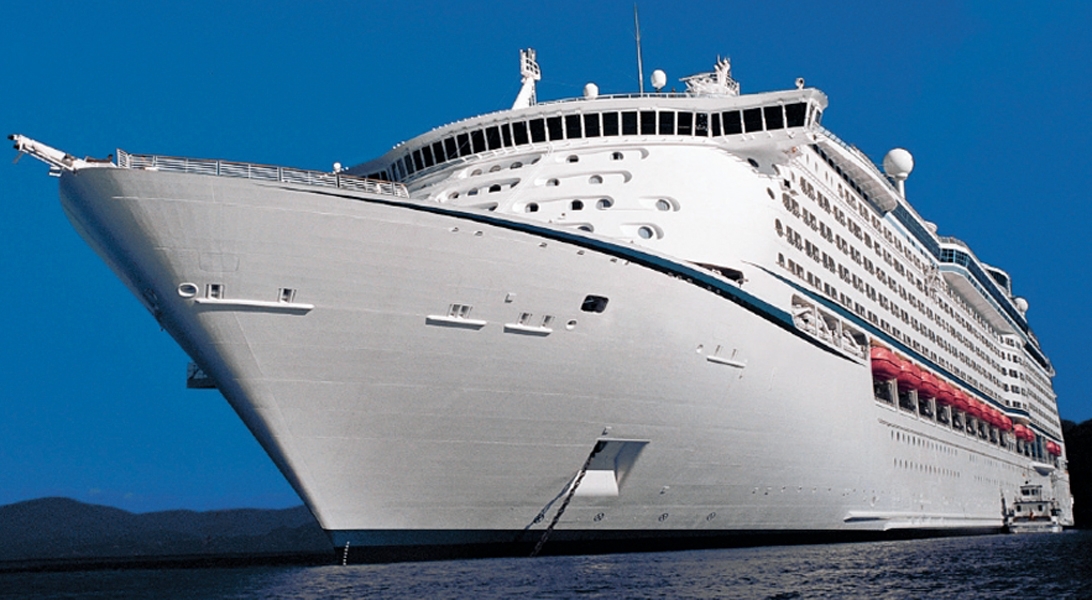














The images shown are for illustration purposes only and may not be an exact representation of what you find on the ship.
The images shown are for illustration purposes only and may not be an exact representation of what you find on the ship.
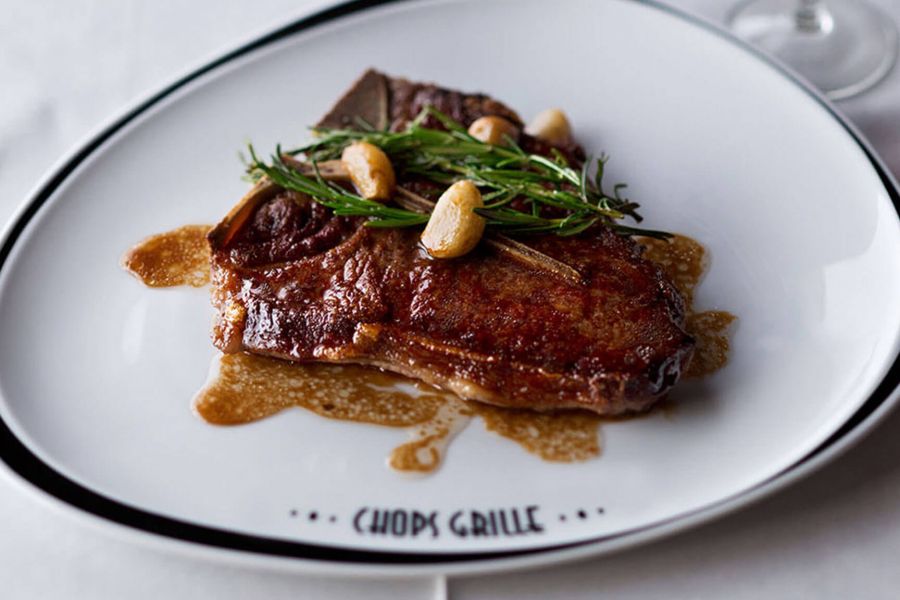
CLASSIC AMERICAN STEAKHOUSE
For over a decade, the chefs at Chops Grille have proudly presented quality, hand-cut steaks at this hallmark Royal Caribbean restaurant. Now, they give you a fresh twist on a favourite, with a revamped menu that brings contemporary flair to traditional steakhouse offerings. Most intriguing: our exceptional prime meat. This prime beef is joined by Maine lobster, grilled branzino and other succulent dishes paired with addictive side dishes and irresistible desserts.
ATTIRE
Smart Casual
INSIDER TIP
Open for lunch on sea days only.
MENU HIGHLIGHTS
The best way to begin a meal at Chops Grille is with the charred beef carpaccio, sliced thin and served rare with fresh arugula, Parmesan cheese, and truffle mustard dressing. If you’re a seafood lover, upgrade your menu with one of the restaurant’s chilled seafood towers — each comes with jumbo shrimp, green-lipped mussels, clams, Jonah crab claws, and Maine lobster. As far as entrees go, the tender filet is one of the most popular items on the menu. If nine ounces is a bit too much for you, opt for the smaller 6-ounce petite filet — it packs in just as much flavour as the standard cut. If you’re a traditionalist, complement your meal with an order of steaming Yukon Gold mashed potatoes and creamed spinach, or change things up with Chops’ signature gruyere cheese tater tots and truffled French fries. And don’t forget to save room for a refreshing slice of tart key lime meringue pie or classic New York cheesecake, served with raspberries and lemon confit.
PRO TIP
The chefs at Chops Grille will hand cut, season, and grill each steak to your specifications. When in doubt, don’t be afraid to ask for the chef’s recommendation.

EAT MORE ITALIAN
Every meal at Giovanni’s Table is a family-style celebration of rustic Italian flavour. You’ll find all your favourite Old-World classics on the menu here, like house focaccia served with marinated artichokes, olives and pesto, fluffy gnocchi tossed in a thyme-scented sauce of lamb and root vegetables, traditional risotto finished with porcini and truffle mushroom tapenade and veal osso buco paired with creamy cheese polenta, ripe tomatoes and sautéed green beans.
ATTIRE
Smart Casual
HOW TO PURCHASE
Cruise Planner or Onboard
MENU HIGHLIGHTS
First things first – ask for an order of the house focaccia, which comes with marinated artichokes, olives and pesto. And don’t miss the antipasti per due, an appetiser big enough for two that comes heaped with Italian salami, prosciutto, marinated anchovies, grilled artichokes, Cambozola cheese and more. There are plenty of tasty options to choose from if you’re a pasta lover, from parpadelle with pancetta in a rich radicchio cream, to taglierini tossed with cherry tomatoes, calamari, bay scallops and pesto. And if you’re craving a hearty Italian-style main course, try the polpette alla romana — tender veal meatballs in a rich tomato-herb sauce — or the costolette d’agnello alle erbe — grilled lamb chops served in a Merlot reduction with baby vegetable caponata and sautéed spinach.
PRO TIP
Giovanni’s Table is a great restaurant to dial up date night. If you’re celebrating a special occasion, just let the staff know ahead of time. They’ll help make it extra special!
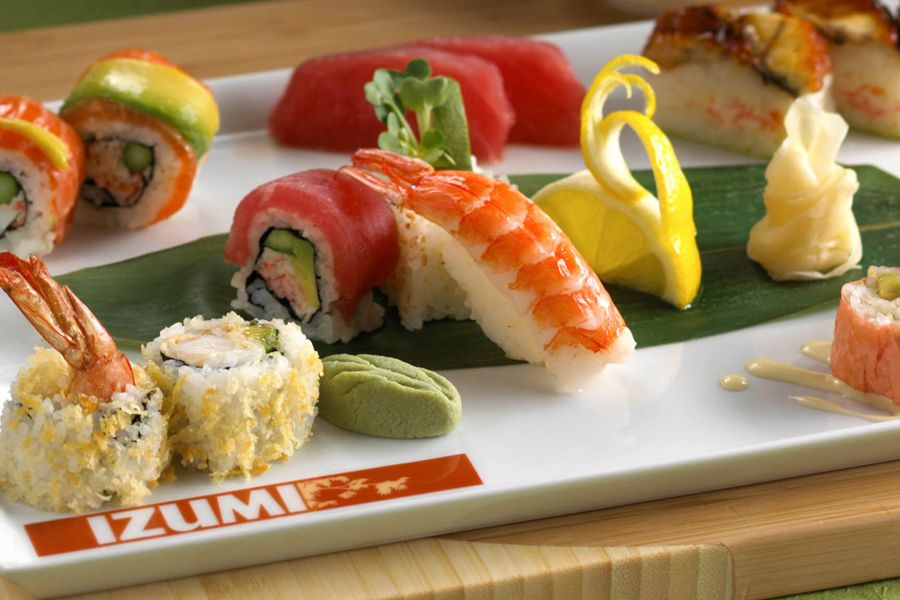
ASIAN FLAVOUR THAT ROCKS
From expertly rolled sushi, fresh sashimi, and delicate nigiri, to izakaya-style appetisers and flavourful meats cooked perfectly on ishiyaki grilling stones — this hard-rocking spin on the fleet favourite Izumi is one specialty dining experience you don’t want to miss out on.
ATTIRE
Smart Casual
HOW TO PURCHASE
Cruise Planner or Onboard
MENU HIGHLIGHTS
At Izumi Sushi & Hot Rocks, every meal begins with a complimentary appetiser of edamame served with course kosher salt. Level up your meal with a deep-fried firecracker spring roll, filled with tender shrimp, crabmeat, cream cheese and sambal chili. If you like spice, try the tuna wasabi carpaccio, sliced thin and paired with the house ponzu olive oil, wasabi aioli, masago smelt eggs, garlic chips and jalapeno. For sushi lovers, the Izumi spider roll is a must — it comes filled with tempura soft shell crab, creamy avocado, masago, and sweet unagi sauce. And of course, you can’t leave without trying something from the ishiyaki hot rock section of the menu. Go all out with the surf and turf experience — you’ll enjoy a half lobster tail, beef tenderloin, and assorted Asian vegetables served sizzling on a hot cooking stone and accompanied by white or fried rice and a selection of delicious homemade dipping sauces.
PRO TIP
Can’t decide what to order from the menu? Look for items with a symbol indicating the chef’s recommendations.
The images shown are for illustration purposes only and may not be an exact representation of what you find on the ship.
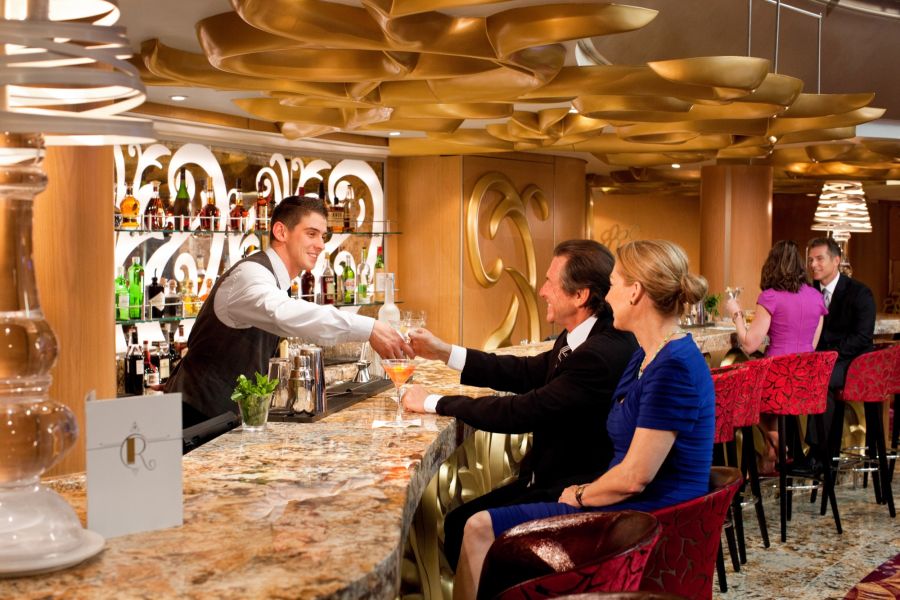
SHAKING UP THE CLASSICS
Swanky, sophisticated, and suffused with retro style, R Bar serves up classic cocktails garnished with vintage vibes. Whether your drink of choice is a dry gin martini, an expertly mixed old fashioned, or the perfect gin and tonic, you’ll find plenty to savour here.
AGE RESTRICTION
21+ on sailings from North America, 18+ on sailings from South America, Europe, Asia, Australia and New Zealand.
MENU HIGHLIGHTS
The vintage décor at R Bar creates the perfect atmosphere to order a classic old fashioned or gimlet, but you should definitely also try one of the signature cocktails on the menu. Those who prefer their drinks on the fruity side will love the Purple Haze, made with Bacardi 8 rum, blue curacao and Pernod, and shaken with pineapple juice, passion fruit puree and a splash of grenadine. For a cocktail that doubles as dessert, opt for the aptly-named Red Velvet Cake, a decadent infusion of limoncello, dark chocolate liqueur, crème de cacao white and strawberry puree. If you’re craving something smooth, but strong, there’s the Green Goddess. It’s a potent blend of Belvedere vodka, Hennessy, blue curacao and mango puree, topped off with a twist of lemon. And for fans of fizzy drinks, it doesn’t get better than the Let’s Get Fizzical, a refreshingly light combination of passion fruit puree, apple juice and St-Germain elderflower liquere topped with prosecco.
PRO TIP
The bartenders here are pros. Let them surprise you with something that’s not on the menu.

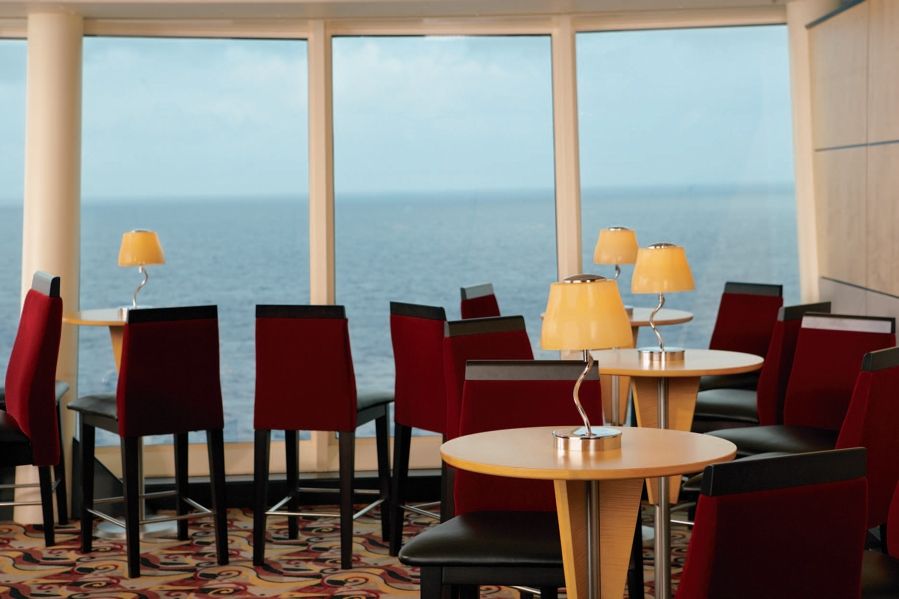
SAVOUR THE SIPS & THE SIGHTS
Our fleet’s signature architectural wonder, the Viking Crown Lounge® is the ultimate spot to soak up panoramic views while you sip your favourite cocktails. Catch the sunset through its floor-to-ceiling windows, then linger as the space comes alive with strobe lights, live music, and plenty of action on the dance floor.

Peace, quiet, and your next great read – find it all at the well-stocked library, featuring a variety of genres, plus tables for cards and board games. Everything’s complimentary for your enjoyment.
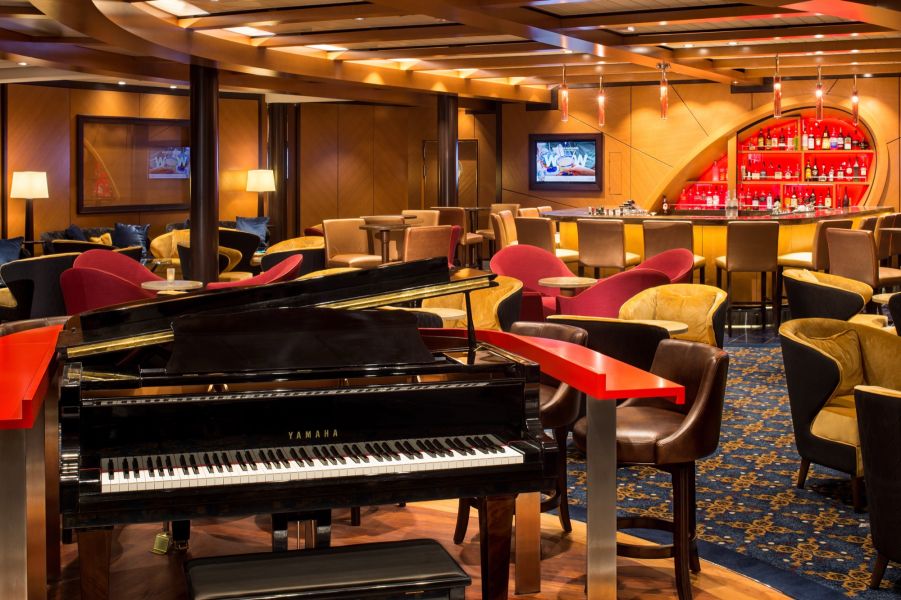
LIVE MUSIC & MASTERFUL MIXING
Wrap up your night at Schooner Bar, where perfectly mixed cocktails and live entertainment come together in a warm-lit nautical-themed lounge. Cozy up in a seat under the mast, by the portholes, or right by the gleaming grand piano. The sing-along's about to being.
HOW TO PURCHASE
Beverage Package or A La Carte
AGE RESTRICTION
21+ on sailings from North America, 18+ on sailings from South America, Europe, Asia, Australia and New Zealand.
MENU HIGHLIGHTS
If you love a great old fashioned, you’ll find five versions of it on the menu at Schooner Bar, including a tropical twist that blends muddled cherries and pineapple with orange bitters and Malibu Coconut rum, and an innovative New Fashioned that brings in pink grapefruit, fresh raspberries, and a little bit of Southern Comfort. You can also dial up your night with a glamorous champagne cocktail, topped with Domaine Chandon and sweetened with an Angostura-doused sugar cube. Or sip your way across the Caribbean with a Zacapa rum-spiked daiquiri, shaken hard and double-strained, or a classic Papa Doble, prepared with Bacardi Superior rum, lychee and grapefruit juice. If you’re a fan of the Tom Collins, you’ll find that, too — plus four additional versions that each spotlight a different spirit.
PRO TIP
Up for something different? Let the bartender know what your favourite spirit is, and ask them to whip you up a surprise.
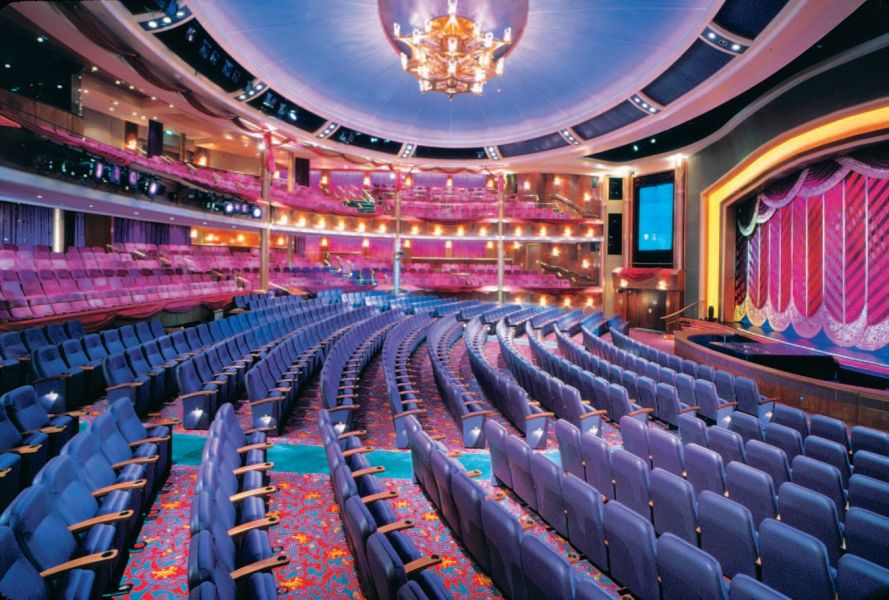
Standing five decks high (from orchestra pit to domed ceiling), the impressive theatre showcases contemporary musical stage productions, West End style shows and stand up comedians.
Broadway Rhythm & Rhyme - ENTER STAGE RIGHT
Sing along to your favourite show tunes as the rhythm, rhyme, words and music of Broadway transport you to NYC.
Music In Pictures - SCENE STEALING SOUNDTRACKS
The silver screen takes centre stage as classic soundtracks come to life.
The images shown are for illustration purposes only and may not be an exact representation of what you find on the ship.
The images shown are for illustration purposes only and may not be an exact representation of what you find on the ship.
| 7 nights aboard the Voyager of the Seas | |||
| Evening entertainment & Broadway style shows | |||
| Choice of traditional or anytime dining | |||
| Drinks Packages available | |||
| Speciality Restaurants (charges may apply) | |||
| 24-hour room service | |||
| Port Taxes and Fees | |||
 | ABTA and ATOL Protection* | ||
Date 4th Aug 2025 |
Nts 7 |
Please Call for Availability |
Date 4th Aug 2025 |
Nts 7 |
Please Call for Availability |
Fusion Cruises when selling travel arrangements is a trading name of The Midcounties Co-operative Ltd. Fusion Cruises is an Accredited Body Member of Midcounties Co-operative Travel Consortium. (ABTA:P6652, ATOL:6053).
Book with Confidence. We are a Member of ABTA which means you have the benefit of ABTA’s assistance and Code of Conduct.
Some of the flights and flight-inclusive holidays on this website are financially protected by the ATOL scheme but ATOL protection does not apply to all holiday and travel services offered on this website. This website will provide you with information on the protection that applies in the case of each holiday and travel service offered before you make your booking. If you do not receive an ATOL Certificate then the booking will not be ATOL protected. If you do receive an ATOL Certificate but all parts of your trip are not listed on it, those parts will not be ATOL protected. Please see our booking conditions for information, or for more information about financial protection and the ATOL Certificate go to: www.caa.co.uk
